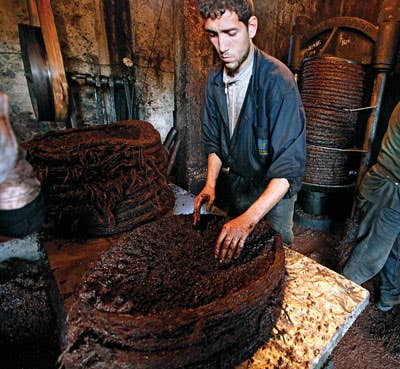
The processing of olives to make oil follows age-old methods. The best olive oil is usually pressed from fruit that is just beginning to turn from green to reddish brown, a stage that Italians call invaiatura, literally "darkening." Oil from olives at this stage has a pleasing pungency and bitterness, an indication of the presence of polyphenols, natural compounds that help protect the oil from rancidity and give it a complex flavor. Today, growers around the world schedule their harvest so that olives can be pressed quickly, ideally within 24 to 48 hours of being picked. The most common pressing method uses continuous-cycle machinery: olives are dumped into steel chambers, crushed into paste by metal hammers or disks, forced through a kneader that begins to extract the oil, and sent to a centrifuge to separate out solids and water. Some mills, like the one featured above in Bejaia, Algeria, still do things the old-fashioned way: crushing olives in a basin with giant stone wheels and then spreading the paste out on woven grass or nylon mats. The mats are stacked atop one another and compressed in a hydraulic press that slowly extracts the liquid, which drips into a tank below; the oil, which rises above any water, is ladled off the top. Though picturesque, the old pressing method has a downside: it exposes the olive paste to the open air for hours, causing oxidation and raising the potential for rancidity.
Keep Reading
Continue to Next Story










